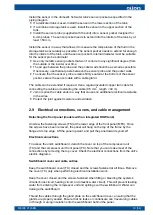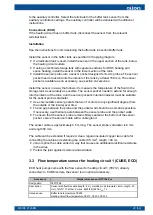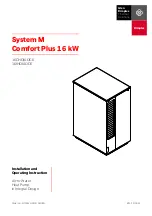
Heating
Buffer not used
The heat pump is connected directly to the building’s heating system without a buffer
tank. The configuration may include a flow-through water tank, but not a buffer tank
regulated by the heat pump.
Connection
Buffer in use
The heat pump is connected to a buffer tank which is regulated by the heat pump.
The tank is equipped with a temperature sensor which is connected to the heat
pump. Any heating circuits in the system are connected to the buffer tank.
Design outdoor
temperature
This temperature is used for selecting the necessary heating capacity for the heating
system. At this outdoor temperature point, flow temperature is at its highest. The
Max flow temperature
(selected for each heating circuit) and the
Design outdoor
temperature
are used to calculate the circuit’s heating curve. See section
Design
outdoor temperature
.
Heating circuit 1
No
The circuit is not in use.
Direct connection
The heat pump is connected directly to the building’s heating system. The system
has no circulation pump or control valve that would be controlled by the heat pump.
Direct connection, with pump
The system has a circulation pump which is controlled by the heat pump.
Circuit used
Valve control
The system has a circulation pump and a 3-way control valve, both of which are
controlled by the heat pump.
Min flow
temperature
The system will keep the flow temperature determined by the heating curve above
this temperature value. Usually, the minimum flow temperature should be set at or
slightly above the required room temperature. Usually, the value should be set to
+20...+25 °C.
Max flow
temperature*
The maximum flow temperature when the outdoor temperature matches the
Design outdoor temperature
setting. The system will keep the flow temperature
determined by the heating curve below this temperature value. For floor heating,
the maximum flow temperature setpoint is usually around 35 °C (concrete floors) or
45 °C (wooden floors). Check the temperature value from the floor or floor heating
supplier (or from the applicable plans and specifications).*
Heating curve
adjust**
Start by setting the minimum and maximum temperature. The flow water
temperature can be adjusted using a six-point heating curve. This menu allows you
to configure each individual point separately.
Curve values should be tuned in during the first few heating seasons.**
*It is not advisable to use the heat pump to cure floor structures. If curing floors:
● Keep the temperature considerably lower than usual (typically no more than 20 °C) before the
concrete slab has cured and after the floor has been tiled.
● Increase the temperature gradually over a longer period of time.
● Keep the temperature as even as possible.
● Check the temperature values and curing times from the floor or floor heating supplier (or from plans
and specifications).
**An example of typical value adjustments:
1. If the room temperature is too cold when the outdoor temperature is −10 °C, slightly increase the flow
water setpoint at outdoor temperature points −13 °C and −7 °C.
2. Wait for at least two or three days to see if the change has made a difference.
3. Readjust the curve if necessary.
Heating circuit 2 and 3
See the instructions for heating circuit 1 setup. The circulation pump and control valve for heating circuit 2
and 3 require an auxiliary controller.
M8006 2123EN
33 (54)
Содержание CUBE 10 EasyAce
Страница 1: ...M8006 2123EN 10 June 2021 CUBE and ECO INSTALLATION AND COMMISSIONING...
Страница 2: ......
Страница 51: ...Pump curves Wilo Yonos PARA GT 7 5 Grundfos UPMXL GEO 25 125 M8006 2123EN 49 54...
Страница 57: ......
















































